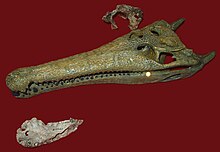Harpacochampsa
| Harpacochampsa Temporal range: Early Miocene
| |
|---|---|

| |
| skull | |
| Scientific classification | |
| Kingdom: | Animalia |
| Phylum: | Chordata |
| Class: | Reptilia |
| Order: | Crocodilia |
| Superfamily: | Gavialoidea |
| Genus: | †Harpacochampsa Megirian, Murray & Willis 1991 |
| Type species | |
| †Harpacochampsa camfieldensis Megirian, Murray & Willis 1991
| |
Harpacochampsa is a poorly known Early Miocene crocodilian from the Bullock Creek lagerstätte of the Northern Territory, Australia. The current specimen consists of a partial skull and fragments of a long slender snout reminiscent of that of a false gharial, demonstrating that it was a piscivore in life.[1] It was originally tentatively placed within Mekosuchinae,[1] although this has been frequently disputed,[2] as mekosuchines do not have such long, thin snouts.[3] Phylogenetic studies have placed Harpacochampsa within Mekosuchinae, as a basal member of Crocodyloidea, or as a member of Gavialoidea.[2]

Below is a cladogram from a 2018 tip dating study by Lee & Yates simultaneously using morphological, molecular (DNA sequencing), and stratigraphic (fossil age) data that shows Harpacochampsa as a gavialid:[4]
| Gavialidae |
| ||||||||||||||||||||||||||||||||||||||||||||||||||||||||||||||||||||||||
References[]
- ^ a b Willis, P. M. A., "Review of Crocodilians of Australasia Archived 2009-09-30 at the Wayback Machine" (pdf).
- ^ a b Jorgo Ristevski; Gilbert J. Price; Vera Weisbecker; Steven W. Salisbury (9 June 2021). "First record of a tomistomine crocodylian from Australia". Scientific Reports. 11 (12158): 12158. Bibcode:2021NatSR..1112158R. doi:10.1038/s41598-021-91717-y. PMC 8190066. PMID 34108569.
- ^ Brochu, Christopher A, American Zoologist, June 2001 "Crocodylian snouts toward adaptive radiation".
- ^ Michael S. Y. Lee; Adam M. Yates (27 June 2018). "Tip-dating and homoplasy: reconciling the shallow molecular divergences of modern gharials with their long fossil". Proceedings of the Royal Society B. 285 (1881). doi:10.1098/rspb.2018.1071. PMC 6030529. PMID 30051855.
- Mekosuchinae
- Miocene crocodylomorphs
- Crocodiles of Australia
- Prehistoric pseudosuchian genera
- Prehistoric archosaur stubs


